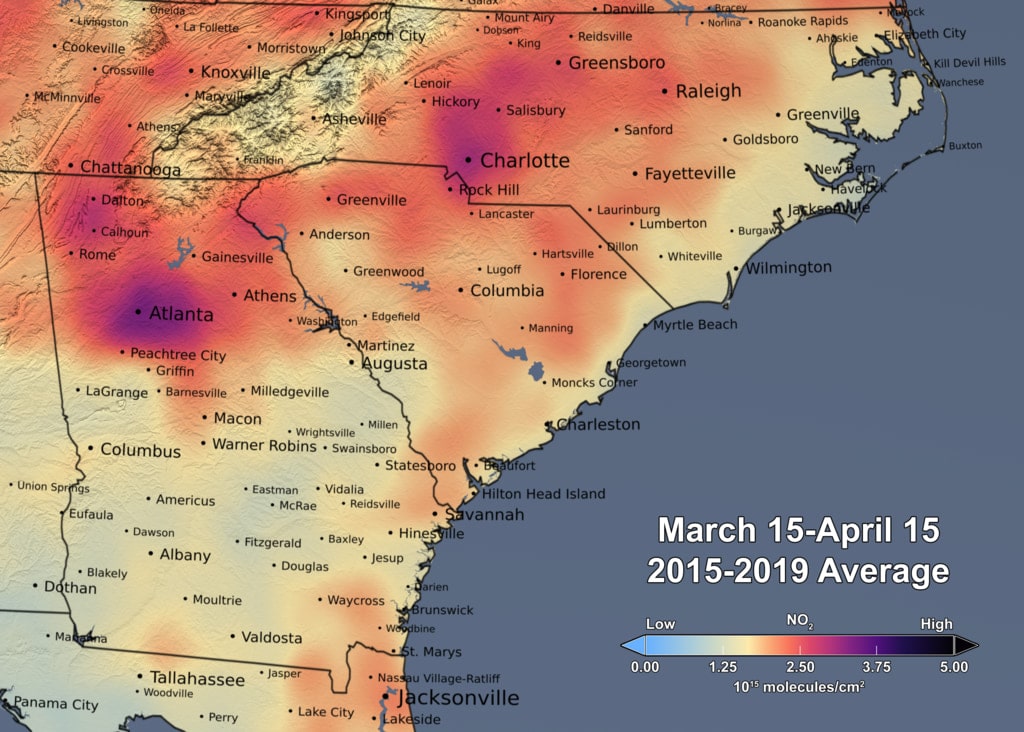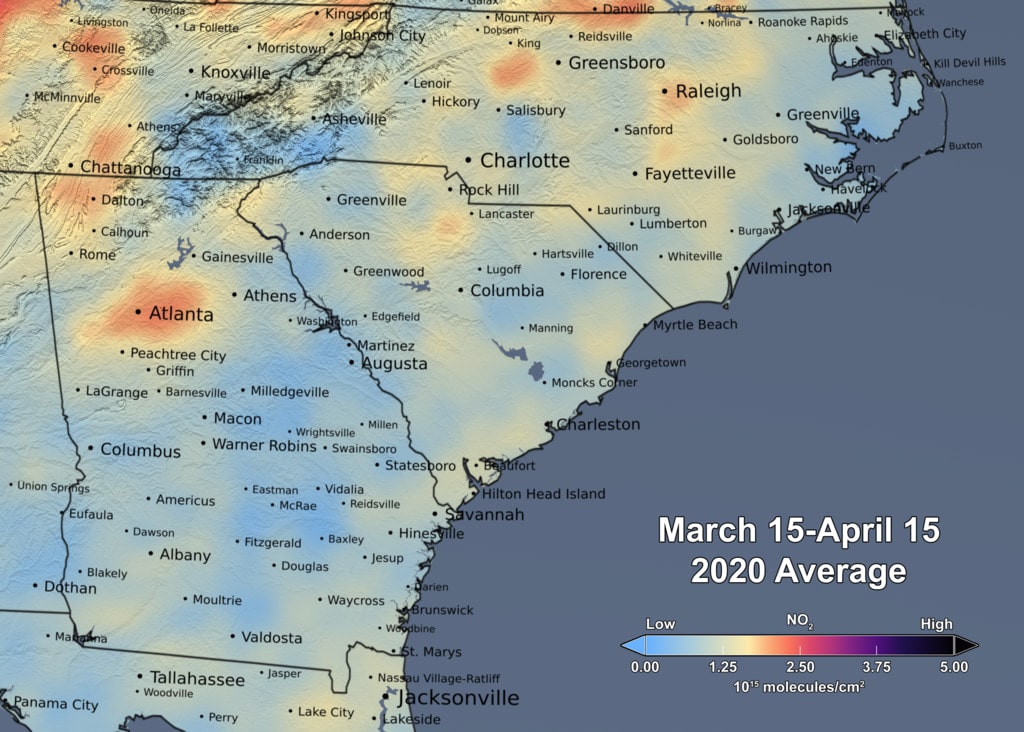 2020 will be a year we will always remember. The novel coronavirus (COVID-19) has brought havoc to our world. Here in the United States, stay at home orders were issued in late March and early April. While these say at home orders have had many effects on the economy, one positive impact has been on the reduction of air pollution.
2020 will be a year we will always remember. The novel coronavirus (COVID-19) has brought havoc to our world. Here in the United States, stay at home orders were issued in late March and early April. While these say at home orders have had many effects on the economy, one positive impact has been on the reduction of air pollution.
At the beginning of the shutdown, news outlets were already beginning to report on a decreased level of air pollution. The BBC reported on March 19th that Carbon Monoxide (CO) emissions in New York City had been reduced by nearly 50% compared with last year (McGrath, 2020). On March 22nd, CNBC noted significant decreases in pollution in China (Newburger, 2020). More recently, studies have shown that Nitrogen Dioxide (NO2) has decreased by as much as 60% and Particulate Matter emissions of 2.5 microns or less (PM2.5) have gone down by 35%, compared to last year.


While businesses and society contemplate how and when to return to work, now is the time for facilities to consider how the COVID-19 downturn can affect future air permitting for planned projects. Some industries, like oil and gas production, have had to reduce operations to compensate for the reduction in overall travel. Other industries, like pulp and paper, have seen an increase in production as they are considered essential operations (we found out how important toilet paper really is!). Whichever end of the spectrum your facility is on, this time of pandemic response may have an impact on facility emissions and it’s important to analyze what future permitting impacts my apply.
The following are a couple of implications to consider for impacts on air pollution permitting.
- Change in Lookback Period for Baseline Actual Emissions (PSD/NNSR Permitting)
For major sources or major source projects which may be close to the Prevention of Significant Deterioration (PSD) or Nonattainment New Source Review (NNSR) permitting thresholds, your baseline actual emissions (BAE) could be affected. BAE is needed to evaluate the total change in emissions from the proposed project. It’s the reference point that you use to determine the size of the increase in air emissions from the project (Projected Actual Emissions from the new project – Baseline Actual Emissions = Project Increases).
To determine BAE, a facility can look back 10 years immediately preceding the proposed project construction date or application submittal date. During the 10-year lookback period, the facility selects any 24-month consecutive period with emissions from the operating unit on a per pollutant basis to be the BAE. In simpler terms, it means a facility would select the highest 24-month actual emissions period from a unit in the 10-year lookback window.
During the COVID pandemic response, if a facility has been idle or operating at reduced capacity, it could negatively impact the lookback period by dropping out higher historical operating periods (8+years). This could negatively impact a facility looking to permit a project which may be close to PSD thresholds.
Alternatively, if a facility has increased it’s operating capacity to aid in response to the COVID pandemic, it may help to create a higher BAE point and “restart” the BAE clock, so to speak, giving the facility several more years to consider a project.
A fictional scenario is presented in Figure 2 as a helpful illustration. In this example, the PM10 BAE would be in jeopardy of falling out of the 10-year lookback period and a new BAE would have to be selected. If the COVID pandemic has shuttered a facility’s operations, it has effectively reduced the amount of advantageous operating time to include within the lookback period. Instead, if a facility is ramping up operations for COVID response, then a new, more favorable BAE could be selected prior to the beginning of the 10-year lookback period. Then if the project were to be put on hold, or planned for further in the future, the BAE analysis would still be valid for several years.

- Impact on Nonattainment Status
 Given the aforementioned reduction of air pollution from the stay-at-home orders, the drop in measured air pollutants could affect National Ambient Air Quality Standard (NAAQS) nonattainment status. NAAQS are the limits on atmospheric concentrations of pollutants that the EPA has identified as harmful to the public and environment. Areas with a 3-year average measured data that are above the NAAQS are considered nonattainment, which requires stricter permitting and compliance measures to reduce air quality back within the NAAQS. There are several areas that currently listed as nonattainment or are very close to nonattainment status. For example, the Baton Rouge Louisiana area was redesignated from nonattainment to an attainment area in 2017 (U.S. Environmental Protection Agency, 2020). Since that time, Table 2 shows that in 2017 and 2018 the measured ozone 8-hour data indicates that the area is above the 2015 NAAQS standard of 0.070 ppm. The economic slowdown during the 2020 COVID pandemic may help lower the 3-year average to keep the area in attainment status. Other areas of the country could likewise potentially benefit from the reduced levels of pollution observed during this time.
Given the aforementioned reduction of air pollution from the stay-at-home orders, the drop in measured air pollutants could affect National Ambient Air Quality Standard (NAAQS) nonattainment status. NAAQS are the limits on atmospheric concentrations of pollutants that the EPA has identified as harmful to the public and environment. Areas with a 3-year average measured data that are above the NAAQS are considered nonattainment, which requires stricter permitting and compliance measures to reduce air quality back within the NAAQS. There are several areas that currently listed as nonattainment or are very close to nonattainment status. For example, the Baton Rouge Louisiana area was redesignated from nonattainment to an attainment area in 2017 (U.S. Environmental Protection Agency, 2020). Since that time, Table 2 shows that in 2017 and 2018 the measured ozone 8-hour data indicates that the area is above the 2015 NAAQS standard of 0.070 ppm. The economic slowdown during the 2020 COVID pandemic may help lower the 3-year average to keep the area in attainment status. Other areas of the country could likewise potentially benefit from the reduced levels of pollution observed during this time.
| Table 2 – Example of Borderline Attainment/Nonattainment Status | ||
| Year | Baton Rouge Ozone Data, 8-hour (ppm) | NAAQS Limit (ppm) |
| 2016 | 0.071 | 0.070 |
| 2017 | 0.073 | |
| 2018 | 0.074 | |
| 2019 | 0.070 | |
(U.S. Environmental Protection Agency, 2019)
Summary
Although this has been a challenging time for companies to wade through how to appropriately respond to the COVID pandemic, companies should consider how this time could impact future project permitting. One impact could be due to a change in operations in response to the COVID pandemic. Larger projects or facilities could have their historical BAE be affected, either positively or negatively, depending on the situation. A second impact could be on ambient air quality for a facility’s region or area. Certain areas that are on the borderline of NAAQS attainment could benefit from reduced travel and regional air pollution.
In any case, facilities should be cognisant of their historical actual emissions and their area’s ambient air quality to capitalize on any advantageous permitting opportunities. PPM hasair pollution permitting experts throughout the southeast to assist companies that may have questions in regards to their permitting standards or compliance. If you have any questions or want to discuss facility emissions or PSD permitting strategies for your upcoming project, please feel free to reach me at brandon.bass@ppmco.com or 205-836-5650.
Contributed by:
Brandon Bass, P.E.
Birmingham, AL Office
(205) 836-5650
References
McGrath, M. (2020, March 19). Polluting gases fall rapidly as coronavirus spreads. BBC News. https://www.bbc.com/news/science-environment-51944780
Newburger, E. (2020, March 22). Air pollution falls as coronavirus slows travel, but scientists warn of longer-term threat to climate change progress. CNBC. https://www.cnbc.com/2020/03/21/air-pollution-falls-as-coronavirus-slows-travel-but-it-forms-a-new-threat.html
Schindler, T. (2020, May 13). Reductions in nitrogen dioxide associated with decreased fossil fuel use resulting from COVID-19 mitigation. NASA Scientific Visualization Studio. https://svs.gsfc.nasa.gov/4810
U.S. Environmental Protection Agency. (2019, August 15). Air quality statistics report. US EPA. Retrieved May 18, 2020, from https://www.epa.gov/outdoor-air-quality-data/air-quality-statistics-report
U.S. Environmental Protection Agency. (2020, April 30). EPA Greenbook – Louisiana Nonattainment/Maintenance status for each County by year for all criteria pollutants. United States Environmental Protection Agency. Retrieved May 18, 2020, from https://www3.epa.gov/airquality/greenbook/anayo_la.html
U.S. Environmental Protection Agency. (2020, April 30). U.S. EPA Greenbook – 8-Hour ozone Nonattainment areas (2015 standard). United States Environmental Protection Agency. Retrieved May 18, 2020, from https://www3.epa.gov/airquality/greenbook/map8hr_2015.html

